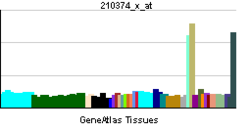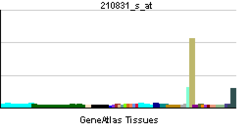Prostaglandinski E receptor 3
| edit |
| Prostaglandinski E receptor 3 | |||||||||||
|---|---|---|---|---|---|---|---|---|---|---|---|
| Identifikatori | |||||||||||
| Simboli | PTGER3; EP3; EP3-I; EP3-II; EP3-III; EP3-IV; EP3e; PGE2-R | ||||||||||
| Vanjski ID | OMIM: 176806 MGI: 97795 HomoloGene: 105703 IUPHAR: EP3 GeneCards: PTGER3 Gene | ||||||||||
| |||||||||||
| Pregled RNK izražavanja | |||||||||||
 | |||||||||||
 | |||||||||||
 | |||||||||||
| podaci | |||||||||||
| Ortolozi | |||||||||||
| Vrsta | Čovek | Miš | |||||||||
| Entrez | 5733 | 19218 | |||||||||
| Ensembl | ENSG00000050628 | ENSMUSG00000040016 | |||||||||
| UniProt | P43115 | Q6PDF2 | |||||||||
| RefSeq (mRNA) | NM_000957.2 | NM_011196.2 | |||||||||
| RefSeq (protein) | NP_001119516.1 | NP_035326.2 | |||||||||
| Lokacija (UCSC) | Chr 1: 71.32 - 71.51 Mb | Chr 3: 157.23 - 157.31 Mb | |||||||||
| PubMed pretraga | [1] | [2] | |||||||||
Prostaglandinski E receptor 3 (EP3) je prostaglandinski receptor, kodiran PTGER3 genom.[1]
Receptor
Ovaj protein je član familije G protein spregnutih receptora. On je jedan od četiri receptora identifikovana za prostaglandin E2 (PGE2). Ovaj receptor ima mnoštvo bioloških funkcija, što obuhvata varenje, nervni sistem, bubrežnu reapsorpciju, i aktivnosti materičnih kontrakcija. U stomaku, on inhibira lučenje želudačne kiseline.
Ispitivanja na miševima sugeriraju da ovaj receptor takođe posreduje odgovor na adrenokortikotropni hormon kao i formiranje groznice.
Varijacije
Više alternativno splajsovanih transkriptnih varijanti kodira osam distinktnih izoformi.[1]
Reference
Literatura
- Kotani M, Tanaka I, Ogawa Y i dr.. (1995). „Molecular cloning and expression of multiple isoforms of human prostaglandin E receptor EP3 subtype generated by alternative messenger RNA splicing: multiple second messenger systems and tissue-specific distributions”. Mol. Pharmacol. 48 (5): 869–79. PMID 7476918.
- Duncan AM, Anderson LL, Funk CD i dr.. (1995). „Chromosomal localization of the human prostanoid receptor gene family”. Genomics 25 (3): 740–742. DOI:10.1016/0888-7543(95)80022-E. PMID 7759114.
- Schmid A, Thierauch KH, Schleuning WD, Dinter H (1995). „Splice variants of the human EP3 receptor for prostaglandin E2”. Eur. J. Biochem. 228 (1): 23–30. DOI:10.1111/j.1432-1033.1995.tb20223.x. PMID 7883006.
- An S, Yang J, So SW i dr.. (1995). „Isoforms of the EP3 subtype of human prostaglandin E2 receptor transduce both intracellular calcium and cAMP signals”. Biochemistry 33 (48): 14496–14502. DOI:10.1021/bi00252a016. PMID 7981210.
- Regan JW, Bailey TJ, Donello JE i dr.. (1994). „Molecular cloning and expression of human EP3 receptors: evidence of three variants with differing carboxyl termini”. Br. J. Pharmacol. 112 (2): 377–85. PMC 1910333. PMID 8075855.
- Yang J, Xia M, Goetzl EJ, An S (1994). „Cloning and expression of the EP3-subtype of human receptors for prostaglandin E2”. Biochem. Biophys. Res. Commun. 198 (3): 999–1006. DOI:10.1006/bbrc.1994.1142. PMID 8117308.
- Kunapuli SP, Fen Mao G, Bastepe M i dr.. (1994). „Cloning and expression of a prostaglandin E receptor EP3 subtype from human erythroleukaemia cells”. Biochem. J. 298 (2): 263–7. PMC 1137934. PMID 8135729.
- Adam M, Boie Y, Rushmore TH i dr.. (1994). „Cloning and expression of three isoforms of the human EP3 prostanoid receptor”. FEBS Lett. 338 (2): 170–174. DOI:10.1016/0014-5793(94)80358-7. PMID 8307176.
- Chang C, Negishi M, Nishigaki N, Ichikawa A (1997). „Functional interaction of the carboxylic acid group of agonists and the arginine residue of the seventh transmembrane domain of prostaglandin E receptor EP3 subtype”. Biochem. J. 322 (2): 597–601. PMC 1218231. PMID 9065782.
- Kotani M, Tanaka I, Ogawa Y i dr.. (1997). „Structural organization of the human prostaglandin EP3 receptor subtype gene (PTGER3)”. Genomics 40 (3): 425–434. DOI:10.1006/geno.1996.4585. PMID 9073510.
- Ushikubi F, Segi E, Sugimoto Y i dr.. (1998). „Impaired febrile response in mice lacking the prostaglandin E receptor subtype EP3”. Nature 395 (6699): 281–284. DOI:10.1038/26233. PMID 9751056.
- Bhattacharya M, Peri K, Ribeiro-da-Silva A i dr.. (1999). „Localization of functional prostaglandin E2 receptors EP3 and EP4 in the nuclear envelope”. J. Biol. Chem. 274 (22): 15719–15724. DOI:10.1074/jbc.274.22.15719. PMID 10336471.
- Liu J, Akahoshi T, Jiang S i dr.. (2000). „Induction of neutrophil death resembling neither apoptosis nor necrosis by ONO-AE-248, a selective agonist for PGE2 receptor subtype 3”. J. Leukoc. Biol. 68 (2): 187–93. PMID 10947062.
- Kurihara Y, Endo H, Kondo H (2001). „Induction of IL-6 via the EP3 subtype of prostaglandin E receptor in rat adjuvant-arthritic synovial cells”. Inflamm. Res. 50 (1): 1–5. DOI:10.1007/s000110050716. PMID 11235015.
- Strausberg RL, Feingold EA, Grouse LH i dr.. (2003). „Generation and initial analysis of more than 15,000 full-length human and mouse cDNA sequences”. Proc. Natl. Acad. Sci. U.S.A. 99 (26): 16899–16903. DOI:10.1073/pnas.242603899. PMC 139241. PMID 12477932.
- Matsuoka Y, Furuyashiki T, Bito H i dr.. (2003). „Impaired adrenocorticotropic hormone response to bacterial endotoxin in mice deficient in prostaglandin E receptor EP1 and EP3 subtypes”. Proc. Natl. Acad. Sci. U.S.A. 100 (7): 4132–4137. DOI:10.1073/pnas.0633341100. PMC 153060. PMID 12642666.
- Wing DA, Goharkhay N, Hanna M i dr.. (2003). „EP3-2 receptor mRNA expression is reduced and EP3-6 receptor mRNA expression is increased in gravid human myometrium”. J. Soc. Gynecol. Investig. 10 (3): 124–129. DOI:10.1016/S1071-5576(03)00007-8. PMID 12699873.
- Abulencia JP, Gaspard R, Healy ZR i dr.. (2003). „Shear-induced cyclooxygenase-2 via a JNK2/c-Jun-dependent pathway regulates prostaglandin receptor expression in chondrocytic cells”. J. Biol. Chem. 278 (31): 28388–28394. DOI:10.1074/jbc.M301378200. PMID 12743126.
- Richards JA, Brueggemeier RW (2003). „Prostaglandin E2 regulates aromatase activity and expression in human adipose stromal cells via two distinct receptor subtypes”. J. Clin. Endocrinol. Metab. 88 (6): 2810–2816. DOI:10.1210/jc.2002-021475. PMID 12788892.
- Moreland RB, Kim N, Nehra A i dr.. (2004). „Functional prostaglandin E (EP) receptors in human penile corpus cavernosum”. Int. J. Impot. Res. 15 (5): 362–368. DOI:10.1038/sj.ijir.3901042. PMID 14562138.
Vidi još
Spoljašnje veze
- „Prostanoid Receptors: EP3”. IUPHAR Database of Receptors and Ion Channels. International Union of Basic and Clinical Pharmacology. Arhivirano iz originala na datum 2016-06-29.
- p
- r
- u
Drugi | Moždano specifični angiogenezni inhibitor (1, 2, 3) • Cadherin (1, 2, 3) • Kalcitonin • CALCRL • CD97 • Kortikotropin-oslobađajući hormon (1, 2) • EMR (1, 2, 3) • Glukagon (GR, GIPR, GLP1R, GLP2R) • Hormon rasta oslobađajući hormon • PACAPR1 • GPR • Latrofilin (1, 2, 3, ELTD1) • Metuselah-slični proteini • Paratiroidni hormon (1, 2) • Sekretin • Vazoaktivni intestinalni peptid (1, 2) |
|---|
glutamat / feromon
Drugi |
|---|
Frizzled / Zaglađeni
Uvojiti | |
|---|---|
Zaglađeni |
B trdu: peptidi (nrpl/grfl/cytl/horl), receptori (lgic, enzr, gprc, igsr, intg, nrpr/grfr/cytr), itra (adap, gbpr, mapk), calc, lipd, signalni putevi (hedp, wntp, tgfp+mapp, notp, jakp, fsap, hipp, tlrp)






